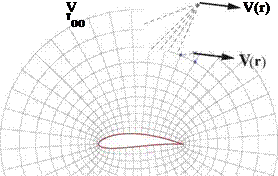Flow-Field Modeling
This chapter will address the specification or description of the velocity field of an aerodynamic flow, in terms of its associated source and vorticity fields. Effective simplifications and idealizations of the flow – field will also be developed within this flow description approach.
2.1 Vector Field Representation Methods
The majority of computational methods for fluid flow prediction use one of two different methods to define the velocity field V(r). These are sketched in Figure 2.1, and described as follows.
1) A grid method where discrete values Vj are defined at the nodes of a grid which fills the entire flow-field. A suitable interpolation scheme is used to interpolate these values to obtain V(r) at any position vector point r within the grid. This is the approach used by modern Computational Fluid Dynamics (CFD) methods which solve the Full-Potential equation, the Euler equations, or the Navier-Stokes equations.
2) A singularity method which uses the velocity fields of source and vortex sheet strengths Aj, 7j which are defined in limited regions of the flow-field, typically at solid surfaces or other boundaries. Weighted integration or summation over these source and vortex strengths, together with an additional freestream velocity V, is used to obtain V(r) at any point in the flow-field. This approach is used by Vortex Lattice and Panel methods for potential flows.

 |
Singularity Method
Figure 2.1: Grid and singularity methods used to represent a velocity vector field V(r).
This chapter will focus on the singularity method 2). In addition to being the basis of Vortex Lattice and Panel flow calculation methods, this flow-field representation is also the basis of many useful engineering approximations, including the formulation of outer boundary conditions in grid-based CFD methods. It also provides an intuitive and physical understanding of aerodynamic flows and general flow behavior, and hence is useful even if the grid-based CFD methods are being employed.











